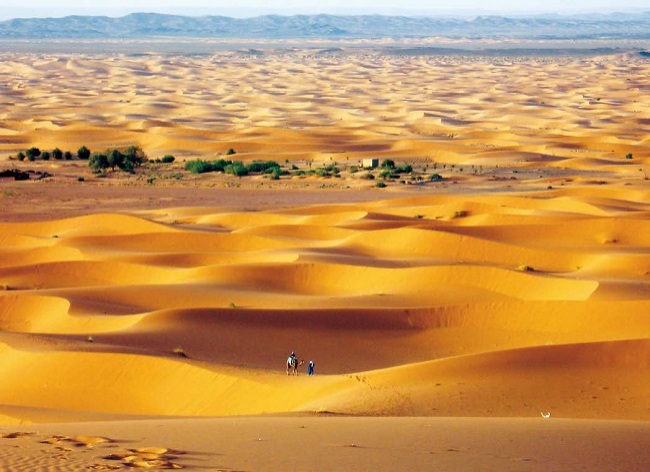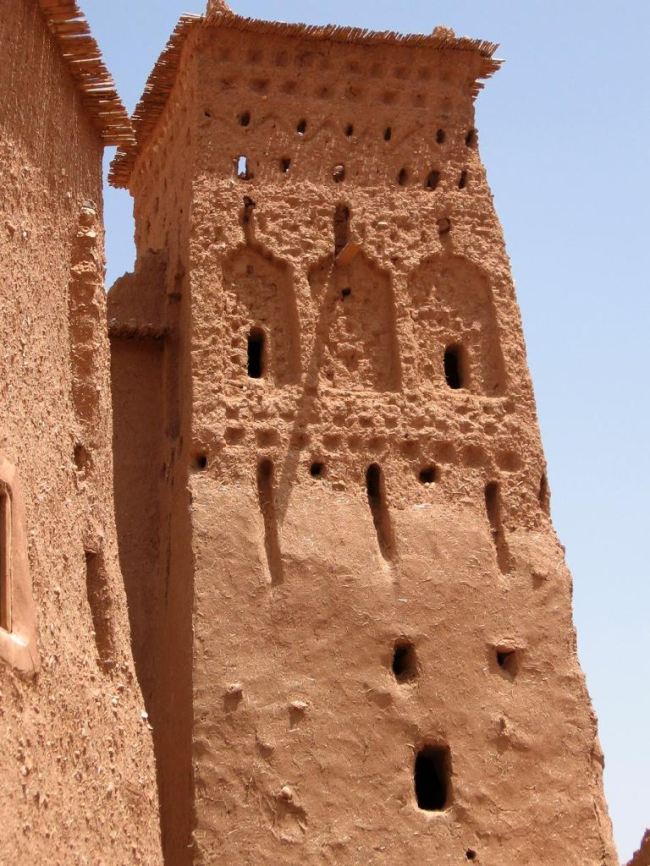ERG CHEBBI, Morocco (AP) ― The bright black silhouettes of our three-camel caravan shone against a tall sand dune like a background drawing of the Three Kings in a Nativity scene.
While Georgie, as I had nicknamed my blonde dromedary camel, plodded through this remote corner of Morocco at the edge of the Sahara Desert, I was transfixed by our reflection ― because it was well past sunset and there was no moon.
With the complete lack of artificial lights, the vault of stars was bright enough to cast shadows, but I was struck by how this desert constantly upends expectations.
Shadows without light, luxuriant bursts of palms among stretches of barren land where you’d swear you’ll never see water again, canyon rock formations that turn out to be fortified villages ― a three-day guided driving loop from Marrakech to the dunes of Erg Chebbi in early summer was one mirage-like surprise after another.
After all, I was following one of Africa’s most mythic, and historic, trading routes: the road to Timbuktu, lined with centuries-old castles, oases and the occasional camel-crossing road warning.
Dune-riding dromedaries
While he liked to play pop hits and discuss U.S. immigration policies in fluent English, Said Ahnana, my driver and guide from the Desert Majesty tour company, had grown up in a nomadic family, herding camels among these dunes.
It took him a minute in a village sewing store to wrap 3 meters of turquoise fabric around my head into a sand-proof turban called a shesh, getting me ready for leaving the road behind, stepping out into the dunes and onto the kneeling camel for a sunset ride.
Waveringly perched above Georgie, I watched the nomadic encampments disappear as we climbed nearly 150 meters up the dunes. I clambered up barefoot for the last leg into a sea of orange and pink sand.
On the way back, another guide, who was leading us on foot in his flowing blue robe, asked what sounded like an either-or question, of which I only understood the word “jamal,” camel in Arabic ― so of course I picked that choice.
That’s how a couple from London and I lucked into riding more than an extra hour in the brilliantly lit, eerily silent night to our camp of wide, round tents nestled in the lower dunes. It turns out I had declined car rides for the last few kilometers.
 |
The route from Marrakech, Morocco, to the Sahara Desert follows one of Africa’s most mythic and historic trading routes: the road to Timbuktu, lined with centuries-old castles, oases and the occasional camel-crossing road warning. (AP-Yonhap) |
Desert canyons
Not all my travels were by camel. With temperatures exceeding 48 degrees Celsius, the air-conditioned SUV came in handy as we traveled more than 1,000 kilometers over steep mountain passes and into pink canyons barely wide enough to traverse.
The roads climbing over the High Atlas Mountains to the 2,260-meter Col du Tichka, or weaving in and out of the Dades Gorge, are contorted enough for any Marrakech snake-charmer.
But I was too busy marveling at the unfolding landscape to feel the turns. Colorless flatness turned into a river lined by blooming pink oleanders in the Dades Gorge and into sheer cliffs tall enough to block the sun in the Todra Gorge.
 |
A tower at Ait Ben Haddou in Morocco’s Ouarzazate province. Ait Ben Haddou is a UNESCO World Heritage site, an example of the region’s distinctive casbahs and ancient fortified villages built from a pressed mixture of clay and straw. (AP/Giovanna Dell’Orto) |
Sand castles and casbahs
The most astonishing eye trick is to behold what nomadic and Berber civilizations over centuries have eked out of this desert.
Wherever there is water are bursting groves of date palms, olive and pomegranate trees. Just after the Skoura oasis, Said jumped out of the car and came back triumphantly holding a fragrant damask rose ― improbably, the area around Kela’a M’gouna is famous for its flowers.
Literally carved out of the sand and rock are scores of fortified villages, casbahs, and turreted castles, “ksars,” that served caravans for a thousand years along the Dades and Draa valleys.
From basic square houses to massive forts, they are made of a pressed mixture of clay and straw called “pise” and decorated with carved geometric patterns reminiscent of indigenous arts from New Mexico to Mali.
Perfectly preserved Ait Ben Haddou and Tamnougalt looked like stage sets ― Morocco’s movie capital, Ourzazate, is nearby. But in their narrow alleys, I came upon flapping laundry lines, a transport donkey parked outside a garden and a public hammam bath ― the ancient routines of daily life.
I had meals of herb salads, lamb skewers and sweet mint tea in cool, clay courtyards that in other times sheltered traders and their camels.
As we drove away, I kept looking back until the earthen walls and unpaved streets melted into the shimmering desert, disappearing like another mirage.
If you go ...
Getting there: My trip was organized by Ourzazate-based Desert Majesty ― www.desertmajesty.com ― as a private, customized “Valleys of the South” round-trip tour from Marrakech, which has an international airport. Except for tips and drinks, the tour covered everything including lodging at Hotel Restaurant Camping Berbere de la Montagne Gorges du Dades ― www.berbere-montagne.ift.fr ― in the Dades gorge, and Auberge Sandfisch ― www.sand-fish.com ― in the dunes. Fall and spring are the best seasons to travel here.









